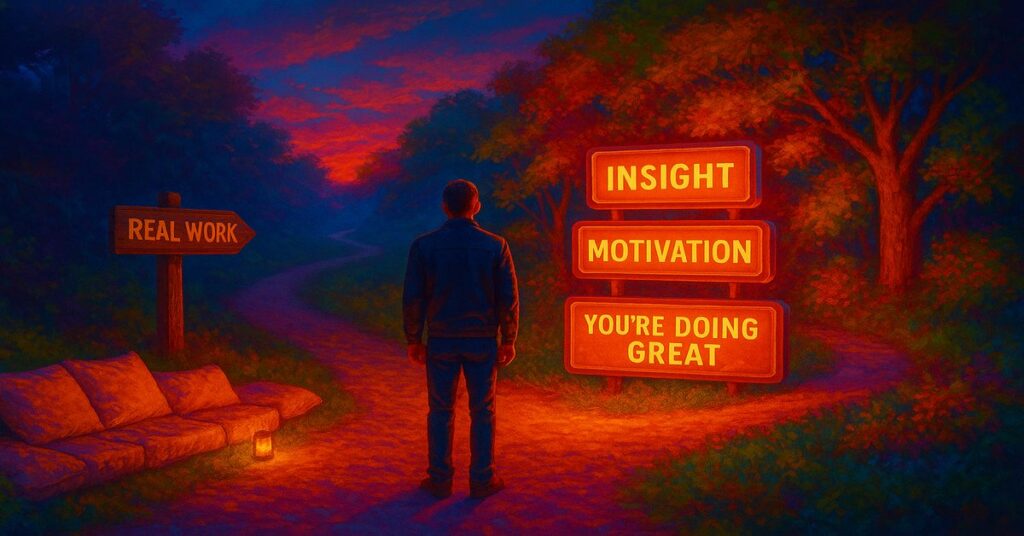“Healing is painful. Comfort is familiar. Most people choose familiar and call it growth.”
Let’s stop pretending that changing your lock screen to a quote about “alignment” means you’ve dealt with your abandonment issues.
There’s a huge, rarely discussed difference between healing vs comfort psychology—and if we’re being honest, most of us are knee-deep in the latter while posting about the former.
This isn’t a judgment. This is a wake-up call. Because fake healing is keeping you stuck. And deep down, you know it.
💡 What Is Comfort Psychology?
Comfort psychology isn’t a formal clinical term. It’s a modern behavior pattern: engaging in wellness habits that feel like healing but don’t demand internal change.
It’s emotional Febreze. The feelings are still there—you’ve just sprayed lavender on top.
Common Signs of Comfort Psychology:
-
Constantly watching mental health reels without applying a thing
-
Saying “I’m protecting my peace” when you’re actually avoiding accountability
-
Joining healing circles and sound baths… but you still haven’t apologized to your mom
You’re not healing. You’re decorating your discomfort.
Healing vs Comfort Psychology: What’s the Real Difference?
| Comfort Psychology | Real Healing |
|---|---|
| Avoids discomfort | Embraces discomfort |
| Surface level (aesthetic) | Root level (transformative) |
| Feels soothing | Feels disorienting at first |
| Looks good on social media | Happens in silence |
Healing isn’t about becoming better. It’s about becoming real. Which often means facing parts of yourself you’ve spent years trying to avoid.

Why So Many People Mistake One for the Other
Because comfort feels like progress.
We live in a culture that confuses insight with change. You read a thread about emotional regulation and suddenly feel like you’ve done something… when really, you’ve just added another tab to your browser of avoidance.
The human brain is wired to reduce pain.
But comfort offers a quick dopamine hit. That’s why so many of us keep rewatching self-help videos, redoing the same journaling prompts, or attending the same “trauma-informed” breathwork classes… all while avoiding the actual work.
🧠 Why Healing Is So Hard (And So Worth It)
Real healing means:
- Letting go of old identities
- Sitting in silence without distractions
- Making amends
- Calling yourself out—privately
- No one claps. No one “likes.” No filter.
It’s the spiritual version of cleaning out your garage. Cobwebs, old boxes, the creepy doll from 2002—and yeah, it smells like mildew at first. But it’s the only way you can actually make room for something new.
🧪 Case Study: From Comfort to Clarity
Let me tell you about someone we’ll call “Lena.”
Lena thought she was healing. She did therapy. She did breathwork. She lit candles and saged her apartment every Sunday.
But she was still attracting emotionally unavailable people. She still snapped at her mom. She still numbed with Instagram every night.
Eventually, she realized: she was talking about healing more than doing it.
When she finally started digging into her fear of rejection, her people-pleasing tendencies, and the trauma she swore she “already worked through”—that’s when things got hard… and finally started to shift.
How to Tell If You’re Actually Healing
Ask yourself:
- Do your actions align with your insights?
- Are you repeating cycles while blaming “bad energy”?
- Are you more focused on being seen healing… than actually healing?
A great breakdown of this comes from this article
🎯 Practical Ways to Shift From Comfort to True Healing
- Unfollow “healing influencers” who sell vibes over value
- Journal about what you’re avoiding—not what you’re grateful for
- Get radically honest about your role in your pain
- Try actual therapy, not just TikTok psychology
- Sit in silence for 30 minutes with no distractions. If that terrifies you, lean in.
What Happens When You Leave the Comfort Cocoon?
You’ll lose people.
You’ll feel disoriented.
You’ll be tempted to go back.
But eventually, your nervous system will adapt. You’ll realize healing is less about control and more about surrender.
You’ll stop craving the soft blur of avoidance. And you’ll start craving clarity—even when it stings.

Final Truth: If It’s Too Comfortable, It’s Probably Not Healing
Let’s be clear:
Healing isn’t about perfect routines and clean habits.
It’s about digging through the messy, awkward, raw stuff and staying in the room long enough to see who you really are.
If you’re comfortable, you might just be avoiding the real work.
But if you’re crying into your cereal, confronting your past, questioning your patterns, and waking up at 3AM to write down a realization—congrats.
You’re healing.
And that’s more powerful than anything trending on your feed.
